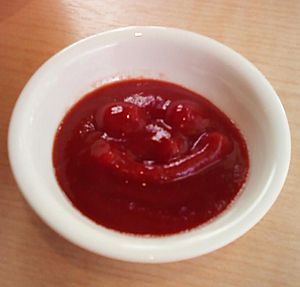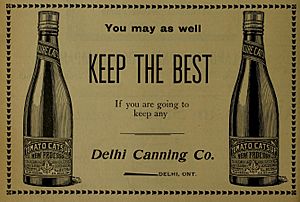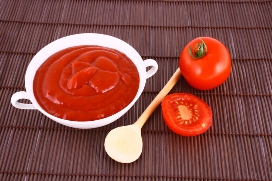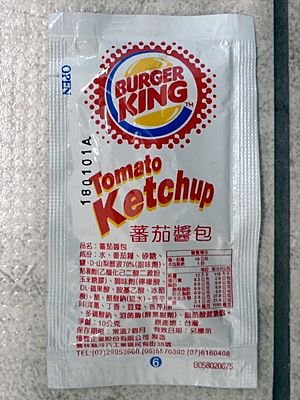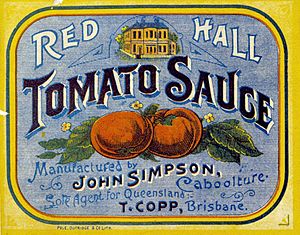Ketchup facts for kids
|
A dish of tomato ketchup
|
|
| Alternative names | Tomato sauce, ketsup, red sauce |
|---|---|
| Type | Condiment |
| Main ingredients | Tomatoes, sugar (or high fructose corn syrup), vinegar, salt, spices, and seasonings |
| 103 kcal (431 kJ) | |
Ketchup is a popular sauce that people use to add flavor to their food. It's a type of condiment, which means it's something you add to a dish after it's cooked, like mustard or mayonnaise.
While today we mostly think of ketchup made from tomatoes, it wasn't always that way! Long ago, ketchup recipes used all sorts of ingredients like mushrooms, oysters, or even walnuts. But now, when someone says "ketchup," they almost always mean tomato ketchup.
Tomato ketchup is usually sweet and a little bit tangy. It's made from tomatoes, sugar, and vinegar. It also has different seasonings and spices. These spices can include onions, allspice, coriander, cloves, cumin, garlic, and mustard. Sometimes, you might even find celery, cinnamon, or ginger in it.
In the United States and United Kingdom, the most popular brand of ketchup is Heinz. They sell a lot of ketchup! Another big brand in the US is Hunt's. In places like the UK, Australia, and New Zealand, people often call ketchup "tomato sauce" or "red sauce."
Ketchup is often used with hot, fried, or sometimes greasy foods. Think about french fries, hamburgers, hot dogs, chicken tenders, and tater tots. It's also great with hot sandwiches, meat pies, cooked eggs, and grilled or fried meat. Sometimes, ketchup is even used to make other sauces or dressings, or its flavor is added to snacks like potato chips.
Contents
The Story of Ketchup
The idea of ketchup started a long time ago in China, in the 17th century. The Chinese made a sauce from pickled fish and spices. They called it kôe-chiap or kê-chiap, which meant "the brine of pickled fish."
In the early 1700s, this sauce reached the Malay states (which are now Malaysia and Singapore). English explorers and traders tasted it there. The local word for the sauce was kicap or kecap. This word then changed into the English word "ketchup." English settlers brought ketchup with them to the American colonies.
For a while, people in North America also used the spelling "Catchup." This spelling was common around 1690.
Ketchup Before Tomatoes
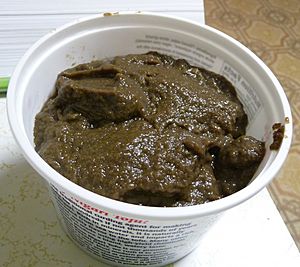
Before tomatoes became the main ingredient, ketchup was often made from mushrooms. In the United Kingdom, mushroom ketchup was very common. Recipes for ketchup started appearing in British and American cookbooks in the 18th century.
One cookbook from London in 1742 showed a fish sauce that had mushrooms added to it. Soon, mushrooms became the most important ingredient. From about 1750 to 1850, the word "ketchup" often meant any thin, dark sauce made from mushrooms or even walnuts.
In the United States, mushroom ketchup was made by British colonists as early as 1770. Today, you can still find mushroom ketchup in the UK, but it's not as popular as tomato ketchup.
The Rise of Tomato Ketchup
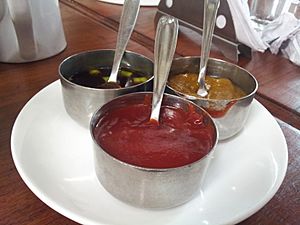
Many different kinds of ketchup were made over time. But the tomato version didn't become popular until about 100 years after other types. An early recipe for "Tomata Catsup" from 1817 still included anchovies, which showed its link to the old fish sauces. By the mid-1850s, the anchovies were gone from the recipes.
James Mease shared a tomato ketchup recipe in 1812. Then, in 1824, another recipe appeared in The Virginia Housewife, a famous cookbook. American cooks also started adding sugar to ketchup in the 19th century. As the century went on, tomato ketchup became more and more popular in the United States. It was popular even before fresh tomatoes were widely eaten.
At first, farmers sold tomato ketchup locally. Jonas Yerkes is known as the first American to sell tomato ketchup in bottles. By 1837, he was selling and distributing it all over the country. Other companies soon started making their own ketchup. F. & J. Heinz launched their famous tomato ketchup in 1876.
As ketchup began to be made in factories, more sugar was added to help preserve it. This led to the sweet and sour taste we know today. In Australia, sugar was added to "tomato sauce" (their name for ketchup) in the late 1800s. Now, it has just as much sugar as American ketchup.
New Ways to Use Ketchup
When you go to fast food restaurants, you often get ketchup in small packets or tubs. You can tear the side of the packet and squeeze the ketchup out. Or, you can peel off the lid of a tub and dip your food into it. In 2011, Heinz even made a new "Dip and Squeeze" packet that could be opened both ways!
Some fast food places used to have pumps where you could get ketchup into a paper cup. This method has started to come back. It helps save money and is better for the environment than using lots of small plastic tubs.
In 2000, Heinz introduced colorful ketchups called EZ Squirt. They came in green, purple, and even blue! These ketchups were made by adding food coloring to regular ketchup. However, these fun colors were stopped in 2006.
Different Names for Ketchup
The name for this sauce can change depending on where you are. In American English and Canadian English, "ketchup" is the most common word. But in some southern US states and Mexico, people might say "catsup."
In many English-speaking countries outside North America, like Australia and New Zealand, people usually say "tomato sauce." However, in Canada and the United States, "tomato sauce" means a different kind of sauce. It's usually made from tomato paste and eaten with pasta.
In parts of the UK, like Welsh English and Scottish English, some people call it "red sauce." This helps tell it apart from brown sauce. In Canada and America, "red sauce" usually means tomato-based sauces used with pasta dishes.
Images for kids
See also
 In Spanish: Kétchup para niños
In Spanish: Kétchup para niños


